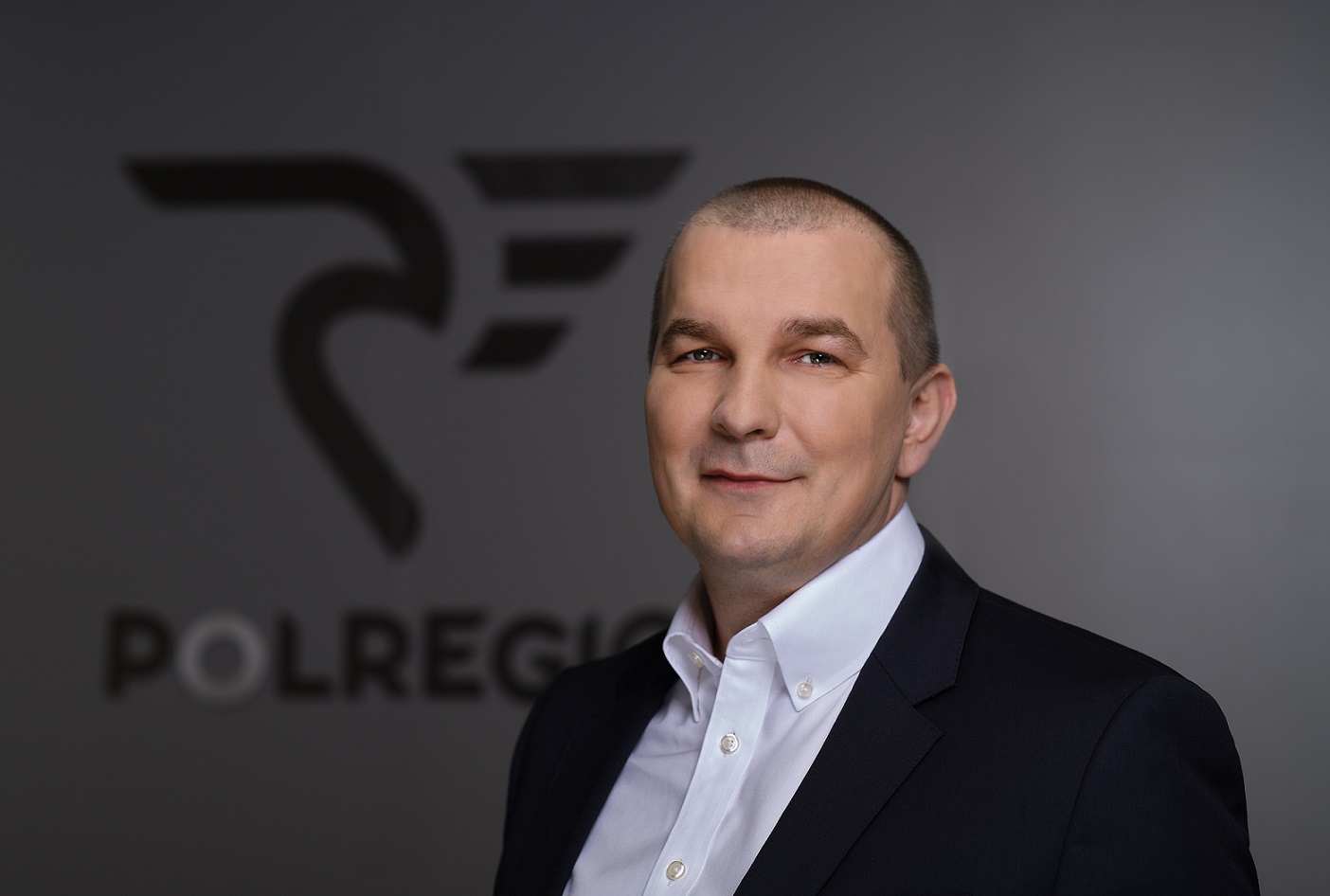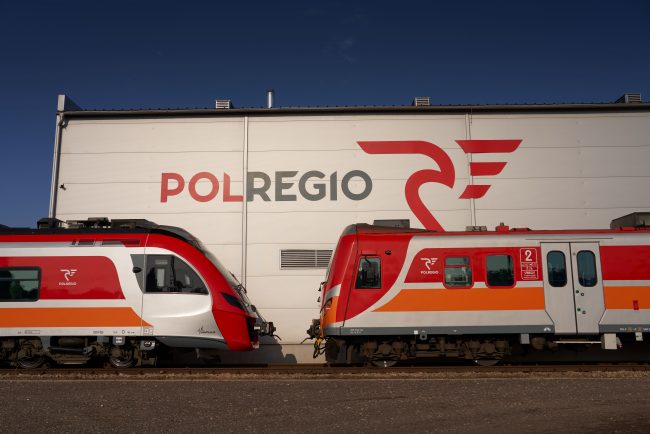

Polregio is not slowing down. Artur Martyniuk, Chairman of the Board of Polregio S.A.
The beginning of the new year is the time for summaries. How was 2021 for Polregio?
Certainly, 2021 was a special year for us. We celebrated our 20th anniversary, transformed into a joint-stock company, presented the largest investment plan in the history of carriers, and recorded a double-digit increase in the number of passengers. All this in the extremely difficult conditions of a pandemic that disrupted many sectors, including rail transport. 2021 was also my first full year as the President of the Management Board of POLREGIO. It was a time of very tiresome work for the entire crew, for which I would like to thank everyone once again. There are new challenges ahead of us, including, above all, a tender for new trains. Moreover, we focus on further increasing of the number of passengers in connection with the expansion of our travel offers and a gradual return to normality in economic and social life.
In rail passenger transport, the primary indicator is the number of people using the services of a given carrier. What results has Polregio achieved in this regard?
In 2021, we transported a total of almost 70 million people, which means an increase by 12% compared to 2020. Our current market share is over 25%. I am convinced that this year, we will exceed the level of 70 million passengers, and in the next few years the company will serve over 100 million passengers, which will strengthen our position as a market leader. For this purpose, in 2021, we announced an extremely ambitious investment plan. It provides for the purchase of nearly 300 new trains and the modernization of several dozen more.
What amounts of investment are coming into play and where will the company get the money from?
We will allocate up to PLN 7 billion for this purpose. The investment plan is prepared in variants, so we are prepared for any scenario. The funds for purchases will come from European funds, debt financing and the company’s own funds. It is worth emphasizing that the effective use of external financing in the amount of PLN 7 billion is also associated with the involvement of own funds, which in turn requires us to maintain financial discipline. Here, the key factor is the fact that the company – as the only one amongst largest railway carriers – achieved a positive financial result on core operations for 2020 and 2021. This is an important argument in talks with, let’s say banks, that would like to participate in the financing of our investment plan. In 2021, financial institutions reported themselves to us, to take part in the investment plan. We have secured over PLN 9 billion in long-term contracts with local governments, until 2030. All this makes our negotiating position completely different from two years ago.
We also want to spend some of the funds on investments in our rolling stock maintenance points. Modern trains are advanced units that require appropriate facilities for their servicing. It is our intention to ensure that the largest possible part of their maintenance takes place within the company’s structures. It is not only a guarantee of due diligence, but also the most cost-effective solution. In addition, after modernization, rolling stock maintenance points will be able to carry out more orders for external entities, and thus increase revenues from outside of our core business.



Are investments in regional railways likely to pay off?
Polregio’s mission is to provide rail transport also in smaller towns. By definition, the regional railway is not profit-oriented and you simply have to pay extra for connections in many small towns. This is the case all over Europe and we are no exception. It is worth remembering that the dynamic railway changes for the better, so far have mainly affected long-distance carriers. Pendolino is the symbol of change here. Today, most of the inhabitants of Poland have to travel to a large city by Pendolino or by regional train, often units that fail to meet standardized expectations, i.e. without air conditioning or wi-fi. Our intention is that, through the investment plan, every passenger should have their proverbial Pendolino where they live – regardless of whether it is a large city or a small town. For this we need 300 new trains, and that is a realistic goal. In the coming years, there will be sufficient funds available for the replacement of rolling stock, including for regional railways. At the same time, the market will liberalize and Western players such as DB or Renfe will be able to participate in tenders. It is therefore in the broadly understood social interest, to build a strong regional railway system in the form of a large nationwide operator, in order to be able to effectively compete with carriers with significant financial reserves, rolling stock facilities, and a very efficiently orgaznied, which is the result of many decades of experience in domestic markets.
What is the significance of the regional railway for the inhabitants of Poland?
Regional rail is the primary form of transport for many people. This is confirmed by the results of the research commissioned by Polregio by the Minds & Roses studio. They show that for 60% of respondents, regional rail is an important means of transport, and if we take into account people who have access to regional railways in ther immediate vicinity , this indicator grows to 79%. As many as 30% of people in Poland do not have an alternative means of transport to the regional railway. This shows how important of a role Polregio plays in reducing the phenomenon of the so-called communication exclusion. Moreover, the regional railway is affordable and in the coming years it will be even more competitive than a passenger car. It is worth remembering that from 2025 a new emissions trading system is to enter into force, concerning, among others, liquid fuels. Today we can already see how new cars are becoming more expensive due to the increasingly restrictive exhaust emission standards. Anyway, during the pandemic, even used cars have become more expensive, and the costs of service, insurance and parts are also systematically growing. In this context, a modern train paired with an appropriate offer of at least 8 pairs of trains will attract new passengers to the regional railway. The average level of use of rail transport in Poland is still several times lower than in the Czech Republic per example, so the potential for development is very promising. We can see from the sheer volume in the connections that were reactivated after many years, e.g. involving the town of Konskie, that the regional railway has very good prospects in Poland.
One of the challenges will be to attract young passengers to the regional railways. How are you going to convince the generation born after 2000 to use a service that is quite outdated from their point of view?
Nowadays, a common trend among carriers is to offer mobility as a service, i.e. in the concept of the so-called MaaS (Mobility as a Service). Polregio not only follows the latest trends in mobility, but also intends to set them in the railway industry. In our application you can now check the timetable and buy a ticket. In January this year, we submitted an application to a contest organized by the European Commission under the Connecting Europe Facility (CEF). The aim of this project is to automate and standardize ticket sales. Our new digital ticketing and timetable management platform will use blockchain technology and artificial intelligence. The new system will enable passengers to track train movements in real time and enable live access to information regarding connections, and Polregio will allow for effective management of the commercial offer. This project is the next stage of digital development with the most technologically advanced solutions. Blockchain-based technologies guarantee the highest level of digital security, while advanced artificial intelligence algorithms allow you to adjust the application to user preferences that change over time. In our case, we are talking about at least 70 million passengers per year, so the potential of this project is huge.
Artur Martyniuk is an MBA graduate of IESE Business School in Barcelona. He also studied at Harvard Business School and London Business School. He graduated from Lublin University of Technology, Faculty of Electrical Engineering and Computer Science and a Masters degree in Engineering. He started his professional career at KPMG consulting company, where for many years he managed projects for medium and large Polish companies and multinationals. He also worked at the Swiss branch of Goldman Sachs bank and the Santander Bank headquarters in Madrid. From 2013 to 2020, he was a director of financial advisory at Deloitte, managing projects in many sectors in different countries and in the region of Central and Eastern Europe.
Last Updated on July 26, 2022 by Anastazja Lach